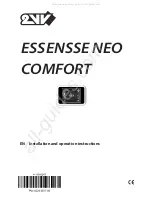
User Guide
2
1. OpenDaylight Controller Overview
The OpenDaylight controller is JVM software and can be run from any operating system
and hardware as long as it supports Java. The controller is an implementation of the
Software Defined Network (SDN) concept and makes use of the following tools:
•
Maven
: OpenDaylight uses Maven for easier build automation. Maven uses pom.xml
(Project Object Model) to script the dependencies between bundle and also to describe
what bundles to load and start.
•
OSGi
: This framework is the back-end of OpenDaylight as it allows dynamically
loading bundles and packages JAR files, and binding bundles together for exchanging
information.
•
JAVA interfaces
: Java interfaces are used for event listening, specifications, and forming
patterns. This is the main way in which specific bundles implement call-back functions for
events and also to indicate awareness of specific state.
•
REST APIs
: These are northbound APIs such as topology manager, host tracker, flow
programmer, static routing, and so on.
The controller exposes open northbound APIs which are used by applications. The OSGi
framework and bidirectional REST are supported for the northbound APIs. The OSGi
framework is used for applications that run in the same address space as the controller
while the REST (web-based) API is used for applications that do not run in the same address
space (or even the same system) as the controller. The business logic and algorithms reside
in the applications. These applications use the controller to gather network intelligence, run
its algorithm to do analytics, and then orchestrate the new rules throughout the network.
On the southbound, multiple protocols are supported as plugins, e.g. OpenFlow 1.0,
OpenFlow 1.3, BGP-LS, and so on. The OpenDaylight controller starts with an OpenFlow 1.0
southbound plugin. Other OpenDaylight contributors begin adding to the controller code.
These modules are linked dynamically into a
Service Abstraction Layer
(SAL).
The SAL exposes services to which the modules north of it are written. The SAL figures
out how to fulfill the requested service irrespective of the underlying protocol used
between the controller and the network devices. This provides investment protection to
the applications as OpenFlow and other protocols evolve over time. For the controller
to control devices in its domain, it needs to know about the devices, their capabilities,
reachability, and so on. This information is stored and managed by the
Topology Manager
.
The other components like ARP handler, Host Tracker, Device Manager, and Switch
Manager help in generating the topology database for the Topology Manager.
For a more detailed overview of the OpenDaylight controller, see the
OpenDaylight
Developer Guide
.








































